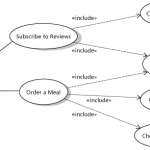At its simplest, a use case diagram is a representation of the interactions of users with a particular system and it depicts the specification of use case. The different types of users of a certain system can be portrayed with a use case diagram and it can also show the various ways they use for interacting with the system. Use case diagrams are used by people in conjunction with textual use case and other types of diagrams also accompany it. Use cases are often used in web and software development to entail the interactions that take place between a user and a system or application.
The use case diagram example is often used by business analysts for documenting how the users of a business interact with its systems, the methods they use and how and where improvements can be made. Because the focus of these diagrams is on the people and not on the system itself, it is easy to highlight the needs of the system and this can lead to a variety of benefits during the product development process. Some of these benefits are discussed here:
Product Discovery
When use cases are defined early on, it gives plenty of time and opportunity to the software development teams for building the right product. Even before a business defines its requirements, problems areas and behaviors can be uncovered by developing use case diagrams. New software products or improvements in current products can be used to address these problems.

Defining Requirements
When functional requirements have to be defined, a natural stepping stone is using use case diagrams. It is easier to describe the functioning of the product by establishing the way a user will interact with the upcoming product. However, the system must support the instructions that have been mentioned in the use case diagrams.
Development
The software development process becomes easy when use case diagrams are being used. It is easy for a business to engineer resources, minimize complexity and let developers focus on a certain stage at one time because use cases align the requirements.
Testing
A very important benefit of use case diagrams is that they help in identifying any error that might occur during the user interaction. The use case diagrams clearly describe the desired outcomes and test criteria can therefore be established without any difficulty. Each individual use case can be matched with test cases, making validation easy.
Communications
Not just software engineers, but the stakeholders like executives, marketers and the users will be able to understand the use case diagram easily. In this manner, effective communication can take place between project managers and product owners. Stakeholders can also be included in the process early on and their input can be taken in regard to the development process. Basically, a use case diagram acts as a bridge between people who understand the problems and those who are aware of how to solve it.
These are some of the reasons why business analysts choose to make diagrams examples for explaining the weaknesses of a business and the process of overcoming them.
Author Bio:
This article use case diagram example has been written by Waqar Hassan. The history of his work as a freelance Blogger, Editor, Writer, SEO Writer, Technical Writer, social media expert, resume & cover letter writer reflects the adaptability he can offer through his work. Creative writing is a field he flourishes in by combining his research and writing expertise in order to produce useful piece of writing that will certainly comprise a compelling result. Waqar Hassan can be contacted at [email protected] and followed at @HassanGill on Twitter.



